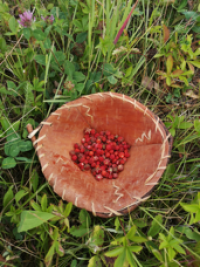Indigenous Language Revitalization and Living Well
February 21st observes International Mother Language Day to promote linguistic and cultural diversity and multilingualism. UNESCO initially recognized this day to acknowledge the importance of those who gave their lives for the Bengali Language Movement in 1952. It has since become a beacon for other cultures who risk having their traditional languages taken from them. It is essential to encourage the use and practice of mother languages to preserve and protect them and promote linguistic diversity and cultural understanding.
Angela Easby is a PhD candidate in the Social Practice and Transformational Change program at the University of Guelph, under the supervision of Dr. Kim Anderson. Angela is Métis and Anishinaabe on her mother’s side, and a member of the Métis Nation of Ontario with ancestral ties to Treaty 3 territory in northwestern Ontario. She is a mother, an Anishinaabemowin learner, a runner, and a beadwork artist.

Image: Strawberries in a birchbark bowl
In 2014, I was attending university on the west coast and feeling homesick. I grew up in central Ontario, and despite the beauty of the west coast, I missed the people and the lands I was used to. One day I saw a flyer for an Anishinaabemowin language circle on campus. Growing up, I never heard the language except for a few words associated with bodily functions (cue my grandma and mom saying ‘don’t forget to clean your jiid!’ when we took a bath as little kids) and a few names of animals. Suddenly, I wanted to learn. Badly. But I was very nervous.
I went anyway, and I made some dear lifelong friends. And it sparked what has now become a lifelong journey of learning Anishinaabemowin and passing it on to my son. Part of that journey is my current PhD work in the Social Practice and Transformational Change program to better understand Anishinaabemowin revitalization in relation to short-term, long-term, and intergenerational movement. Indigenous people move—we’ve always moved. Sometimes returning cyclically to a place, sometimes not. How can we live and work well together so that the process of Indigenous language revitalization is enjoyable, hope-filled, and connected to the reality of mobile lives? This is the question that motivates me as a scholar.
I think that learning Anishinaabemowin impels me to try to live well because it is completely interconnected with the rest of my life, and making progress with the language is interdependent with so many other factors. If I haven’t had a good night’s sleep—which has been the case most of the past 2 years as the mom of a toddler—I often forget or mix up basic grammar or words. Learning Anishinaabemowin encourages me to do everything in my power to set my life up in such a way that language learning and transmission are prioritized. This has had many positive ripple effects as I am reminded to be kind to myself, never give up, be strategic with my energy and efforts, have a sense of humour and a thick skin, speak up when I don’t understand, and prioritize relationships.
This interconnectedness between learning a language and the rest of life means that there is a decolonizing and social justice imperative to Indigenous language revitalization. This isn’t something I could necessarily articulate on day one, when I was just staring blankly at a verb chart. But as I made my way back from Victoria, to Toronto, to Guelph, and now to Peterborough, it has become very clear: Indigenous language learning is inflected with power, privilege, and colonial violence. It’s hard or impossible to read through dense grammar explanations, take a university course, make it to daytime or evening community classes, or travel to immersion opportunities if you can’t afford to take time off work, can’t afford childcare, or simply have more pressing material concerns around safety, housing, or family. Prospective Indigenous learners are also confronted with shame and fear, instilled through colonization and Christianization. I’ve come to believe that supporting Indigenous language revitalization therefore means taking a much, much broader view to support Indigenous communities and prospective learners in a myriad of ways, to break down colonial barriers and make language learning as accessible and integrated into daily life as possible. It is important to not hyper-individualize the responsibility for Indigenous language learning and to take this systems-level view to understand why it’s hard in the first place and therefore what needs to change.
I think Indigenous language learning on campus can be a decolonizing process to examine our own location, including our gifts, privileges, and barriers to learning, and to hone and practice our role in language revitalization and advocacy more broadly. University campuses are one potentially fruitful space for Indigenous students and faculty to experiment with the question: what does it mean to work with the language where you are—wherever that may be—to the best of our collective ability? Knowing, of course, that you will hit obstacles and challenges, and potentially even hard limits. But you will inevitably learn something worthwhile through the attempt.
Who has taught us, who do we wish had been able to teach us, and how are we responsible to them all? And how are we responsible to those who haven’t yet begun their learning journeys or are stalled, because of the intergenerational impacts of colonization or other life circumstances beyond their control? These are the questions I think about often as I ponder the way forward with my own Anishinaabemowin learning. Every day I understand a little more. Mii iw.
~ Written by Angela Easby